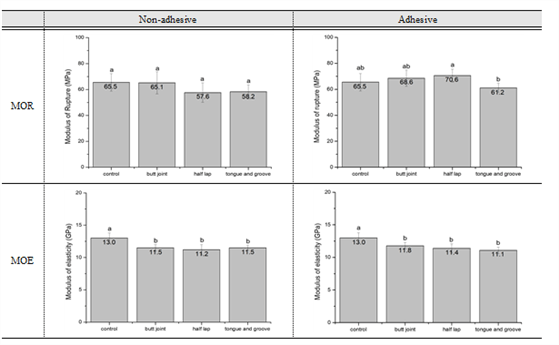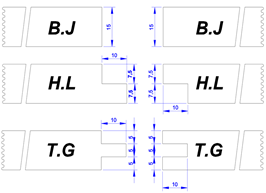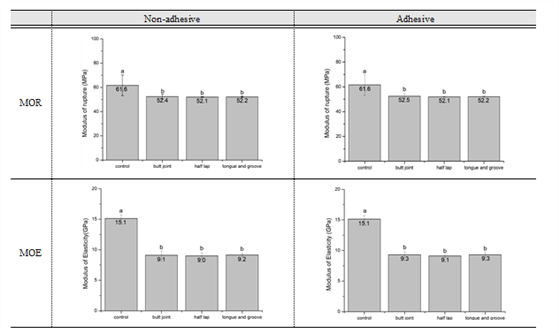1. INTRODUCTION
Global warming phenomena such as abnormally high temperatures and rising water temperature are continuing around the world. This phenomenon is a result of the emission of GHG (greenhouse gases) such as carbon dioxide, methane and nitrous oxide. There is a growing interest in reducing GHG emissions (Jung et al., 2019; Shim et al., 2019). Accordingly, measures are being discussed in all areas such as construction and transportation to reduce GHG emissions. Among them, at the 17th Climate Change Conference in 2011, the effect of reducing GHG by carbon storage of wood products was recognized. Accordingly, interest in the use of wood with GHG absorption and carbon storage effect is increasing (Kim et al., 2019; Chung, 2019; Kim, 2019).
In addition, as GHG reduction becomes mandatory after 2020, interest in wooden buildings around the world has increased, and construction cases of high-rise wooden buildings are increasing. Wooden construction has been in the spotlight as a sustainable construction technology as it not only reduces energy consumption and GHG, but also uses wood as a major building material in the long term (Yoo et al., 2019).
Accordingly, not only interest in wood is increasing but also in recent European countries, large-sized wood panel CLT (Cross Laminated Timber) has been developed and used to compensate for fireproofing, soundproofing, and thermal storage functions, etc., which are weaknesses of lightweight wooden structures. When CLT is applied as a building member, the construction period is shortened and the insulation performance and airtightness are improved through the precast modular construction method. This also has the advantage that it can be used as a high-rise wooden building material, so construction cases of high-rise wooden buildings are increasing (Hassanieh et al., 2017; Chang et al., 2018). Construction examples include an 18-floor wooden structure at the University of British Columbia in Vancouver, Canada in 2017, a 9-floor Stadthaus in London, UK in 2009, and a 10-floor Forte wooden structure in Melbourne, Australia in 2012. In London, UK, a bird's-eye view of “Oakwood”, a super-high-rise wooden building, was disclosed, and high-rise buildings using wood are gradually increasing (Kim et al., 2019; Kim, 2019).
As such, CLT used in high-rise wooden buildings is engineered wood in which the lamina layer is stacked orthogonally in the direction of the wood. It is used in regions such as Europe, the United States, and Canada. Recently, among the wood materials to which the composition of CLT is applied, a study on the development and performance of a composite CLT in which laminated veneer lumber (LVL), plywood, and bamboo board are mixed and laminated is in progress (Park et al., 2017; Choi et al., 2015; Choi et al., 2018; Nurdiansyah et al., 2020; Barreto et al., 2019; Wang et al., 2017). In Korea, studies are being conducted on the material properties of CLT using small hardwood and CLT using flame retardant materials, shear walls, joints, and housing performance (heat insulation, sound absorption) of CLT (Jang et al., 2019; Pang et al., 2017; Choi et al., 2018; Oh et al., 2017; Kang et al., 2019; Jung et al., 2020).
In addition to active research on CLT, domestic CLT production facilities are being introduced. CLT is being produced by using domestic larch lamina layer and Ply-lam CLT with plywood mixed and laminated to improve yield (Pang et al., 2019;Choi et al., 2020). In particular, domestically produced larch plywood is used for Ply-lam CLT, and it is easy to manufacture Ply-lam CLT with a length of 2,440mm according to the plywood standard. For CLT, a large-sized wooden panel, the length of a 120 mm-thick modulus of rupture test piece is approximately 3,600mm or more, which is 25-30 times the thickness (ANSI/APA, 2018). However, Ply-lam CLT, in which plywood is mixed and laminated, is required to join the longitudinal direction of plywood when manufacturing panels with the length longer than 2,440mm.
In this study, a plywood bonding method suitable for Ply-lam CLT is derived by analyzing the flexural performance and failure mode according to the lamina layer species, the method of bonding plywood in the longitudinal direction, and whether or not adhesive is applied to the joint.
2. MATERIALS and METHODS
The plywood used to manufacture Ply-lam CLT was used by pre-sale of 15 mm structural larch plywood manufactured by S company located in Incheon, using larch (Larix kaempferi (Lamb.) Carrière). The physical properties of the used structural larch plywood are shown in Table 1. The larch plywood with a thickness of 15 mm, which passed the first grade of KS F 3113 structural plywood standards, was used.
The lamina layers used in the Ply-lam CLT were Douglas fir (Pseudotsuga menziesii (Mirb.) Franco, oven-dry specific gravity 0.52) and larch (Larix kaempferi (Lamb., total weight 0.54) Carrière). Two species of lamina layers were used as the testing materials. Douglas fir lamina layers were classified into mechanical grades E12-13 (MOE: 12-14 GPa) and E9 (MOE: 9-10 GPa) lamina layers. E12-13 (MOE: 12-14 GPa) grade was used as the outermost layer, and the E9 (MOE: 9-10 GPa) grade was used as the intermediate layer. The larch lamina layer was used as a mechanical grade E11 and E9 layers, and the layer composition of Ply-lam CLT was the same as that of Douglas fir. The Douglas fir used was a knotless lamina layer and it was used cut into 15 mm thick, 100 mm wide, and 2,400 mm long. Larch was a knotless lamina layer and was manufactured and used in a thickness of 15 mm, a width of 100 mm, and a length of 2,400 mm through a longitudinal finger joint method.
In this study, a plywood bonding method suitable for Ply-lam CLT was derived by analyzing the flexural performance and failure pattern according to the longitudinal plywood bonding method, and whether or not an adhesive is applied. For this purpose, three types of Ply-lam CLT were prepared according to the no- treatment conditions without plywood bonding and the longitudinal bonding method. As for the longitudinal bonding method of plywood, three bonding methods were selected: Butt Joint (hereinafter referred to as B.J), Half Lap Joint (hereinafter referred to as H.L), and Tongue & Groove Joint (hereinafter referred to as T.G), which are most commonly used for bonding wood in the longitudinal direction. Fig. 1 shows the processing drawing of the plywood according to the bonding method.
In order to compare the flexural characteristics of the plywood by the bonding method, Ply-lam CLT was manufactured by arranging the joint in the longitudinal direction of the plywood to be located in the center of the modulus of rupture test specimen.
Room temperature hardening type phenol-resorcinol resin was used as an adhesive for manufacturing Ply-lam CLT, and the main material (phenol-resorcinol resin) and a curing agent (paraformaldehyde) were mixed with a ratio of 100:30 and used. At this point, the Ply-lam CLT (lamina layer-plywood-lamina layer-plywood-lamina layer) having a thickness of 75 mm (5 ply) was prepared after cold-pressing for 24 hours under a pressure condition of 10 kgf/cm2 and curing for 7 days after applying adhesive based on 150g/m2 of single-sided coating amount. The Ply-lam CLT manufactured for each condition was cut according to APA PRG 320 Standard for Performance-Rated Cross- Laminated Timber and ASTM D 198-15 Standard Test Methods of Static Tests of Lumber in Structural Sizes to be used as test pieces. The manufacturing conditions and the test specimen size of Ply-lam CLT is shown in Table 2.
The prepared flexural performance test piece (75mm (T)×305mm (W)×2,400mm (L)) was tested by Two-Point Loading method among ASTM D 198-15 flexural performance evaluation methods using a universal testing machine (KDPI-130-1). At this point, the span of the test piece was 2,175 mm (29 times the thickness) and the load speed was set to reach the maximum load within about 300 seconds. Modulus of rupture, the deflection and load measured with the maximum load at the center of the specimen were used to calculate the Modulus of Elasticity according to Equations (1) and (2).
P max : maximum load borne by specimen loaded (N)
a: distance from reaction to nearest load point (mm)
b: width of specimen (mm)
d: depth of specimen (mm)
P: increment of applied load on flexure specimen below proportional limit (N)
a: distance from reaction to nearest load point (mm)
b: width of specimen (mm)
d: depth of specimen (mm)
l: span of beam (mm)
△: increment of deflection of neutral axis of flexure specimen measured at midspan over distance and corresponding load (mm)
One-way ANOVA was performed on the calculated results using SPSS (ver. 24.0, SPSS Inc., USA), and the significance of the mean value (P<0.05) was tested by Duncan’s multiple range test.
3. RESULTS and DISCUSSION
The results of the flexural performance of Ply-lam CLT using the Douglas fir lamina layer is shown in Fig. 2. Depending on whether the longitudinal adhesive was applied or not, the same level of strength value was shown for the condition (without longitudinal joint) and the butt joint. When the adhesive was not applied based on the average value, the modulus of rupture decreased by about 10% in the half lap, tongue & groove. When the adhesive was applied, the modulus of rupture decreased by about 7% in the tongue & groove. Regardless of whether the adhesive was applied or not, the modulus of elasticity was reduced by about 11.5% due to the longitudinal bonding method.

The average significance of the modulus of rupture and modulus of elasticity of the plywood of no-treatment condition without longitudinal bonding and the three longitudinal bonding methods was verified (Table 3). When the adhesive was not applied, there was no significant difference between the results of modulus of rupture based on the condition (without longitudinal joint) and the bonding method. However, there was a significant difference in the condition where the adhesive was applied.
Moreover, the modulus of rupture (F=2993, p=0.031) showed a significant difference based on whether the adhesive was applied or not, and the adhesive application condition showed a higher level of strength. However, the modulus of elasticity (F=0.739, p=0.602) did not show a significant difference based on whether the adhesive was applied or not. The half lap joint bonding method showed the highest modulus of rupture performance when the adhesive was applied, and the butt joint showed the highest modulus of rupture performance when the adhesive was not applied.
The flexural performance results of Ply-lam CLT using larch lamina layer and larch plywood is shown in Fig. 3.
A significant difference was found as a result of verifying the average significance of the modulus of rupture and modulus of elasticity of conditions without longitudinal bonding of plywood and 3 types of longitudinal bonding methods. Based on the longitudinal bonding, the modulus of rupture decreased by about 15% and the modulus of elasticity decreased by about 40%.
As a result of verifying the significance of modulus of rupture and modulus of elasticity according to the bonding method, there was no significant difference according to the bonding method. In addition, the modulus of rupture (F=0.059, p=0.997) and the modulus of elasticity (F=0.364, p=0.868) were not significantly different depending on whether the adhesive was applied or not.
In the condition without longitudinal joint, failure starts
from defects such as knots at maximum load, and failure occurs for each layer of 2 ply plywood veneer. On the other hand, when the adhesive is applied to the plywood joint, unlike other joint methods, it was found that a failure of the butt joint passes through the plywood joint of the middle layer when the outermost lamina layer is destroyed, and transmitted directly to the lamina layer of the core (Table 5). However, in the half lap joint, tongue & groove joint, the failure was not transmitted from the middle layer plywood directly to the lamina layer of the core part, and the failure occurred first in the plywood. As a result, it was determined that the failure to the core part was mitigated from being transmitted immediately. In the case of using a radiator pine lamina layer, the effect of strength improvement was shown at the half lap joint and butt joint coated with the adhesive, but the modulus of rupture was not improved because the plywood was first destroyed in the tongue & groove joint.
| Lamina | Larch | Douglas Fir |
|---|---|---|
| Joint method | ||
| Control |

|

|
| Butt joint |

|

|
| Half lap joint |

|

|
| Tongue & groove joint |

|

|
It was analyzed that the failure pattern of the case of not applying the adhesive showed the same result with the case of applying the adhesive (Table 6).
| Lamina | Larch | Doulas Fir |
|---|---|---|
| Joint method | ||
| Butt joint |

|

|
| Half lap joint |

|

|
| Tongue & groove joint |

|

|
4. CONCLUSION
In this study, to evaluate the flexural performance based on the plywood bonding method of Ply-lam CLT, the strength performance based on the application of the adhesive between 2 types of lamina layers, 3 types of plywood bonding methods, and interlayer plywood bonding was compared and analyzed, and the following results were derived.
-
In the case of the Douglas fir layer, the modulus of elasticity decreased by about 11.5% compared to the condition without plywood joint, and the modulus of rupture increased or decreased depending on the adhesive application and bonding method. The optimal conditions were derived as the butt joint without adhesive, half lap joint with adhesive, and butt joint.
-
In the case of the larch lamina layer, the modulus of rupture decreased by about 15% and the modulus of elasticity by about 40% due to the longitudinal bonding. There was no difference based on the bonding method.
-
When using the half lab joint and tongue & groove joint, it is decided that it reduces the load transmitted to the middle layer by primarily preventing the failure on flexure at the joint of the plywood layer.
-
From the results of this study, the larch lamina layer used in the manufacturing process of Ply-lam CLT did not show any difference based on the bonding method. Butt joint and half lap joint method are determined to be suitable when using Douglas fir lamina layer.


